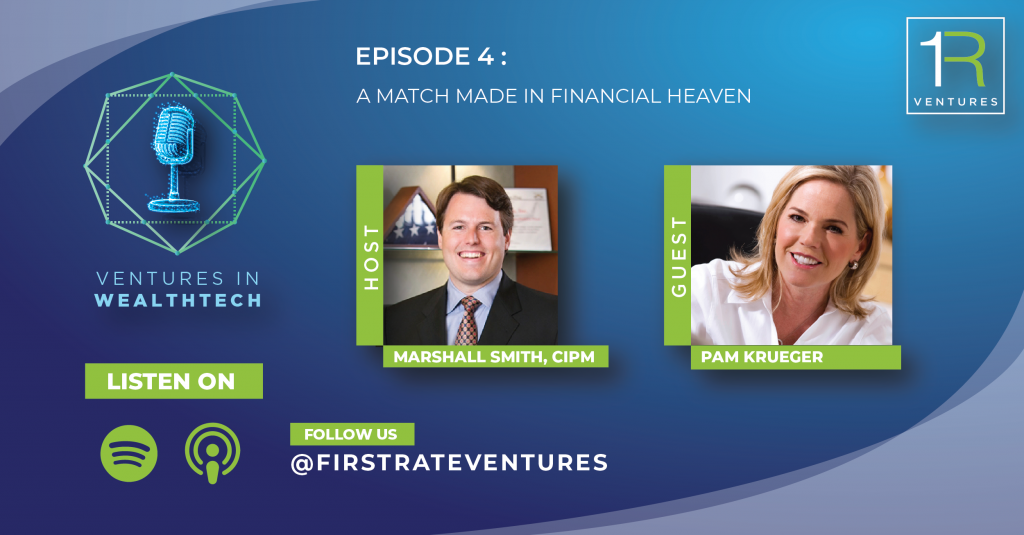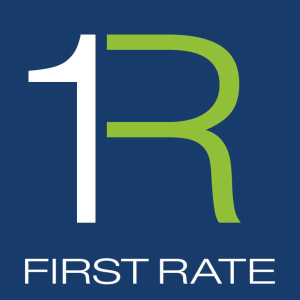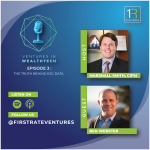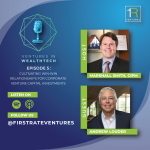A Match Made in Financial Heaven

[00:00:04.630] – Marshall Smith
And welcome to the Ventures and WealthTech podcasts. I’m your host, Marshall Smith, here today with a special guest, Pam Krueger of WealthRamp. Welcome to the show.
[00:00:15.080] – Pam Krueger
Thanks for having me. It’s great to be in Arlington.
[00:00:17.580] – Marshall Smith
Absolutely. Arlington, the American city. We’re here today to talk about wealth management and WealthRamp, the company you founded and started. Just give us a brief background on yourself and the company that you founded.
[00:00:31.910] – Pam Krueger
I did not want to do this. I came to this kicking and screaming. The only reason that I created WealthRamp as a solution to help consumers find vetted fiduciary fee-only financial advisors is because people kept telling me I don’t have any way to find a financial advisor any way that’s reliable that I can trust. I was co-hosting and producing a TV series on PBS stations. 250 PBS stations called MoneyTrack. Our viewers kept saying to me “Pam, you’re always telling us that we could do it ourselves. Digital tools are the way of the future – Robo advisors”, and they said, “Pam give me the name of an advisor because my husband are ready for an advisor”. And it’s 2022 and look at where we are, there’s three ways that people can find a personal financial adviser. Number one you ask a friend right. You go to a cocktail party a referral from why? Because you assume that that friend has done all their homework and they’re so much smarter than you are, so you trust them. Okay number two, they go online and they get sucked into one of these ‘lead generators’ and they open Pandora’s box. When they go through it all of a sudden they get a clown car in their inbox and solicitations from so called advisors and insurance agents that are saying “hey you want my help” and you’re inundated. And then the third way, is the way it’s been since the beginning of time – walk into your nearest Schwab Family.. Merrill Lynch, Morgan Stanley, go with the big brand and get who you get who you get. And you’re never going to get a decision maker. You’re going to get a broker, an agent. That’s why they’re called brokers.
[00:02:29.950] – Marshall Smith
Yeah. So really almost since that sense of anxiety creeping up, and at least in option two and three there, because essentially you’re inviting the solicitation sort of the sales pitch. The fear that I’m just going to buy whatever your incentive to sell. How big of an issue between advisors that want to serve customers in a fiduciary and client centric way and the own investors situation where they’re looking for advice and help… What are the barriers to them? The right type of advisers finding the right type of investors.
[00:03:06.290] – Pam Krueger
Well, 90% of the industry is sales, right? So, you’ve got insurance companies and you’ve got your so-called advisors there and then you’ve got brokerage advisors and they’re both sales models. So, it’s not to say that the advisors don’t have the right intention. It’s not to say that they don’t want to do the right thing. But they’re working for a business model that does not work for the client because that broker works for the company. They don’t work for the client. So, they have to make sales or they don’t make their production. Then there’s 10% of the industry which are independent advisors who ironically are held to a higher fiduciary standard legally than the brokerage firms because they’re independent. So, the rationale is that if you’re going to be an independent adviser the regulators are going to hold you to a higher standard because you’re going to open your business down the street, hang a shingle, ‘Marshall Smith’ “Hello, I’m your financial advisor.” Right. So, they want to hold you to a higher standard. So out there in the land of the independent advisor who’s not connected with a brokerage firm or an insurance company, they all look like trees in the forest. They all look exactly the same. So, one of the biggest problems that great advisors who are truly great, truly fiduciary best practices – one of the biggest challenges is ‘how do I let the world know that I’m different?’ Because they all look the same. They’re all painted with the same paintbrush.
[00:04:36.620] – Marshall Smith
So, how many investors are really trying to do it themselves at this point? So how many people come to you and they’re doing it themselves and the challenges that they have in doing it themselves and what are they looking for versus maybe people who are with an advisor they just don’t like that advisor. Where do you see your solution and what you’re doing? How do you interact with those two populations?
[00:05:04.730] – Pam Krueger
All of it, I’m surprised at the number of doing yourself. First, we have I call us the engineer’s advisor. I should step back and say I have curated a network of independent advisors who I have personally vetted each and every single one – 250 – different specializations, different sizes and they all have passed my rigorous betting on WealthRamp. And then we connect the consumer to the advisor who fits best. So, the advisors are just helping people. They have different types of typical clients. So, getting back over to the DIY, the Do-It-Yourself, I’m surprised at the number of consumers we have who come to me and they say “Pam, I was an engineer at Boeing. I’ve been using spreadsheets forever. I’ve never had an advisor before. I never needed an advisor and I never wanted one. But now I’m getting into my 50’s. Life has become more layered and more complex. I’m married, I have a family. My wife’s parents may need to be taken care of. At the same time, I am worried about saving for college for my kids, saving for retirement buying some more real estate, et cetera.”
So, when life becomes a little bit more complex, the Do-It-Yourself’ers come to us looking for an advisor who will provide them with a collaborative financial planning experience. It doesn’t have to be that they manage your money. You don’t have to say, “I want to hand over my portfolio for you to make all the investments, but I want your advice, advisor, I’m going to do-it-yourself’er, or I want your advice, I want your guidance, and I want ongoing cash flow analysis and stress testing of my plans”. Because at the end of the day, we all want one thing – does not matter who you are on the spectrum – we all want to have peace of mind and confidence that we have a plan that works that won’t let us go to zero.
[00:07:13.380] – Marshall Smith
Yeah. What I really see there is I kind of thought it as you either are a ‘DIY-investor’ or you’re totally ‘outsourced-to-a-fiduciary-advisor-investor’. You’re really painting this middle lane where a lot of the people coming to you, the more sophisticated investors, but they need a second opinion. They want somebody else to question maybe some of those assumptions, and they don’t have to necessarily pay 100 basis points a year on all their assets to get that. And so, it makes total sense. It’s customizing the experience, but this really makes sense because these advisors are crafting something that’s in the customer’s best interest versus, “this is my model, take it or leave it”. That’s really cool, that sort of customized approach. You talked about the matchmaking. So, I’m thinking here, okay, is this like match.com? Is this like ‘swipe left or right’? Who’s getting to decide who’s matched with who? And is that the advisor picking customers? Is this the potential investors picking advisors? Tell us about how that works.
[00:08:14.320] – Pam Krueger
This is a great question. It’s Bumble. Bumble is different from Match.com in that Bumble protects women from being harassed in such a way, where it’s a one-way mirror. When women are matched on Bumble for a date, they can see the guys, but the guys can’t reach them. So, two things happen. It puts the women in the driver’s seat and puts them in control, and the other unintended consequences. The guys love it because then they only wind up talking to girls, women who want to talk to them. What could be better than that? So, I’m doing the same thing with WealthRamp. So, when clients are coming to us – end-users, just consumers, mom-and- pop, do-it-yourselfself’ers, engineers, start-up employees, or whomever it might be – and they’re coming to me, I’m protecting them, but I do not share their data. They own their data. So, when they come through and they get matched and they see as many as – never more than – but as many as three different advisors who fit their circumstances, it is completely a one-way mirror. They can see the advisors. The advisors cannot see them. So, it has to be the consumer who reaches out the client. The prospective client has to reach out and take that step. So, we empower them and the unintended consequences..our advisors love that because our advisors aren’t salespeople.
[00:09:35.370] – Marshall Smith
Talk about a warm lead coming in.
[00:09:38.320] – Pam Krueger
Advisors are not going to pick up the phone and call a “lead”. They only want to talk to prospects who said they want to speak to them. So that allows me to pull in and attract a different level of advisor because these advisors aren’t desperately out there trying to buy leads.
[00:09:56.790] – Marshall Smith
Yeah, it’s like they’ve already been recommended by someone. It’s like a doctor referring you to a specialist. I’m going to take their recommendation and walk in and feel great about I’m going to get great orthopedic advice from an orthopedic specialist. I’m going to get great retirement advice from a specialist who is trained in this area or is specially matched to what I’m looking for.
[00:10:17.390] – Pam Krueger
I was going to mention one trend. You maybe think of it earlier before I forget it. There’s a big trend that’s happening in wealth management right now and that is the value of financial planning and dynamic financial planning. I’m not talking about the old-fashioned – here’s a report – it’s a binder that goes into a drawer that gets dusty. I’m talking about dynamic, fluid, ongoing, responsive financial planning that can again keep you from going to zero in retirement and spending through your money. That trend of the value placed on financial planning has become so much greater than the investment component because of indexing. It’s indexing, it’s ETFs and their strategies and they’re customized. But the portfolio and investing side of it has changed over the years. That’s why the fee models and that’s why things are changing with the value of financial planning being up here.
[00:11:26.230] – Marshall Smith
Yeah, that’s great. But really, it’s a focus on personalization. So, I’m feeling like my advisor is personalizing their advice to my situation. It becomes unique. Whereas the index fund models, I can find online. They’re well publicized. So really the advisor is shifting to that financial advisory and customer-specific planning are really finding that they create a lot of value. So, we talked a lot about just investors and advisors getting matched up individually, are you seeing any trends related to businesses that are thinking about wellness? Financial wellness is a big trend right now that a lot of people are positioning. How do you think businesses, and startups… can they be a part of enhancing their employees’ wellness through solutions like this? What do you think of this and what are you doing today as it relates to businesses?
[00:12:16.280] – Pam Krueger
I call it ‘WealthRamp at Work’, ‘WealthRamp for the Workplace’. And it’s exactly where we’re going because there’s a gap in the workplace. Remember when 401ks, I won’t say they were new, but they were sort of novel back like we’re talking about in the, in the 80s, and then in the 90s it became “we better educate our employees about the 401K because we want them to contribute and understand it”. And then the next thing that cropped up was financial wellness which became much more holistic at work. So financial wellness at work in companies, even in startups, has become a buzzword in a cottage industry. But what they don’t do is they don’t give you access to personal advice. It’s very generic and it’s helpful and it shows that the employer cares. But WealthRamp comes in and fills that void where there’s a gap where the employee might go to the benefits manager and say, “I’m going to roll over my 401K in three years. This is getting serious. I don’t want to talk to the 401k mutual funds person from Fidelity or whoever ever it might be inside the 401k need advice outside the 401K for my real estate, my crypto, all the things I want to do. My wife works at a startup and has ISOs that require complex tax planning… and oh, by the way, we have a child that’s on the autism spectrum. So, we need advice about special needs trust”. And they go to their company because the company is paying them and the company is providing financial wellness benefits and the company in many cases says, “I can’t help you with all that, you’d have to go to an advisor”. So, WealthRamp slots in and becomes the resource.
[00:14:09.410] – Marshall Smith
Got you.
[00:14:09.870] – Pam Krueger
We become the resource and we work with the employer so that the employer can say, “We have a vetted tool, a digital tool called WealthRamp, where you will self-select advisors you’re matched with, it’s private, they can’t contact you because wealth ramp doesn’t share your information with them. And it’s a safe way for us to get you the specialist that you need for those stock options, and that special needs trust and everything else.”
[00:14:37.700] – Marshall Smith
It’s that employee concierge kind of an experience and service. Employers are all looking for ways to create a better environment to retain talent in a challenging economy to do that and to help them with their overall financial wellness is what you’re saying. As many are looking to do that. It’s really cool.
[00:14:56.940] – Pam Krueger
We provide education lunch-and-learn sessions. We just did one two weeks ago for a company in San Francisco with 60 employees, a startup. 40 employees showed up on the Zoom and the questions ranged from, “I didn’t even know I had stock options”, all the way up through the most sophisticated questions about their ISOs, about their incentive stock options plan. Now our advisor was with me on this call. We were there for an hour. We already had the options planned from the employer. Every question got answered and the emojis that were flying back and forth..we could see from between the employees was, “this is great, he actually could answer the questions.”
[00:15:41.830] – Marshall Smith
Okay.
[00:15:42.390] – Pam Krueger
And then the HR person emailed me afterwards and said, “I didn’t even know these things about options. When can you come back?”
[00:15:49.720] – Marshall Smith
Yeah, those are going to be quite opaque.
[00:15:51.830] – Pam Krueger
We bring education into the workplace and then we provide the matching tool, if and only if, someone says they want advice. I’ll never be the person to say, “you need a financial adviser.” I’m the person who says, “when you decide you need help, don’t go anywhere but me because I’ll protect you.”
[00:16:13.800] – Marshall Smith
That’s cool. Well, tell me about your business, and the revenue model of your business. So, everyone’s in, you’re a startup, you’re raising capital in this space, so clearly everyone needs to figure out a win-win way to generate revenue for their business model. You got these two constituencies. Just tell us a bit about how that works with your business.
[00:16:31.510] – Pam Krueger
I wanted to align the stakeholders’ interests as best I could, and the best way I could see that was that I feel that the advisors owe me a referral fee after a client has signed on, but I don’t want that referral fee until I know that that client is situated and with that advisor. So, we don’t generally get the referral fee from that client until after probably three months goes by.
[00:16:57.130] – Marshall Smith
Then it really sticks.
[00:16:58.250] – Pam Krueger
Right. That it’s a sticky relationship. And our advisors have a 98% retention rate, so we are paid in perpetuity, so we have recurring revenue from that relationship. So, it’s in everybody’s best interest that we provide a long-term sticky relationship. That’s how monetarily I wanted to incentivize everybody to do the right thing. We all want the same thing.
[00:17:22.240] – Marshall Smith
Yeah. That alignment enables everyone to feel like they’re not getting something, they’re not being sold something they don’t need, but really put the keys in the hands of the consumer. If that advisor is providing them the plan, the services, the tools, whatever it is that they’re going to end up providing the customized way, then they’re the ones who say yes, they sign that agreement, they work with that advisor.
[00:17:44.260] – Pam Krueger
When it’s done correctly, that fee that they are paying the advisor pays for itself, when it’s done properly.
[00:17:52.610] – Marshall Smith
Yeah, it all works together. So, tell me a bit about your company. So, are you a tech company? Are you a lead-generation company? You’ve raised some capital, so tell us a bit about how you position yourself in the space.
[00:18:09.530] – Pam Krueger
I think that on some days of the week, I feel like a tech company, but we’re really not a product, we’re a service. So, we’re a tech-enabled, tech-powered service. So, we want our tech stack to get more sophisticated, deeper…obviously always. But we’re not putting out a product, it is a service. So, education and marketing and creating this experience for people, that’s how we get most of our clients right now. It is through earned-media. I’ll be interviewed in Oprah for the first time…Oprah magazine coming up at the end of this month, US News and World Report. I do a podcast on PBS Next Avenue with Richard Eisenberg and Terry Savage. And they’re very respected journalists. People find WealthRamp. I don’t go out and buy a lot of eyeballs. We don’t have big budgets. The money we’re raising Marshall, we’re not raising it to put to digital advertising. We definitely want to develop the tech stack. We definitely want to put more money into marketing to companies, employers. I feel the B2B strategy, which is that ‘WealthRamp-at-Work’, ‘WealthRamp-Goes-to-Work-with-You’, to the employer. I think that’s a strategy that can scale us. I think that throwing money at digital ads creates it’s too high a cost.
[00:19:43.350] – Marshall Smith
Customer acquisition costs goes through the roof.
[00:19:46.370] – Pam Krueger
The big lead generators that are actually selling leads, that’s what they do. Let them have that lane. They’re paying lots and lots and lots of money for those ads.
[00:19:56.110] Marshall Smith
But the difference there is that it’s not bumble for the investor where they get to choose who they’re working with, but it’s more like I don’t know what the other versions of the day, it’s just people who are buying leads who are then going to figure out a way to get connected with those leads.
[00:20:09.150] – Pam Krueger
Yeah, exactly.
[00:20:10.730] – Marshall Smith
And it’s the investors data that’s used as the product.
[00:20:14.160] – Pam Krueger
That’s right.
[00:20:14.910] – Marshall Smith
And so, as an investor who gets their data, gets into that, it’s a little bit of the encrypto…it’s talking about the Web 2 versus Web 3. Or in Web 3, you kind of own your data and you allow other people to see it. So, it’s more about data sovereignty, data ownership, and privacy-forward. And so, you’re really positioned more in that sort of a lane.
[00:20:37.710] – Pam Krueger
It just feels like that’s what people want. And after all, this business that I’m in at the end of the day is based on one thing – trust.
[00:20:49.050] – Marshall Smith
Yeah.
[00:20:49.980] – Pam Krueger 2
So, selling leads does not engender trust.
[00:20:53.200] – Marshall Smith
Yeah. So, tell me maybe an example. Do you see people, those DIYs that come in, maybe they’re the engineer, they’ve got intricate spreadsheets. How many of them just keep going at it themselves after they’ve done this? Are you helping them in some way or equipping them in some way that enables them to feel confident that, you know what, I’m going to keep doing it myself?
[00:21:17.490] – Pam Krueger
It’s funny. I’d say that the pattern is that when we have the DIY investor who’s the engineer, and they do connect with an advisor for the financial planning, the cash flow, the stress testing. So over here they’ve got their investment portfolio. They’ve been tending to it – I call that ‘the gardening’ because a portfolio of investments is alive. It’s a living, breathing, changing organism because the markets are going to change, interest rates have changed, and recession could be on the horizon. Maybe it’s shallow, maybe it’s not. All these things are changing you cannot control. So that’s the garden, and you’ve got to weed it, you’ve got to feed it, you’ve got to fertile it, you’ve got to plant. You got to do all the things that it takes to keep the garden alive. So, these DIY investors who have been doing this themselves come to us for the financial planning holistic planning component with eyes on their portfolio, but they don’t want their portfolio managed. But then generally what I’m finding is a year and a half into the relationship, they change their mind and they say, “you know what, Marshall, you’re the advisor. I really got to know you. My wife really likes you. You do the gardening, tax loss harvesting, Roth conversions”.
We had a $10 million client whom I love, he and his wife, who was thinking about traveling to Italy for a year. He was an executive for a tech company. He always handled his own portfolio, but he wanted to help with the financial plan, so he was going to take this trip for like, a year. And our advisor told him he was going to give him a laundry list of things that he’ll need to do while he’s away to keep everything optimized. Dave ended up saying, “you take care of it? Because my wife and I are off on this trip, and we don’t want to”.
[00:23:23.020] – Marshall Smith
At some point, you crossed over that hurdle.
[00:23:25.470] – Pam Krueger
Yeah.
[00:23:26.380] – Marshall Smith
So, it’s really not – for most of your DIY’s – it’s really a matter of when and not if it’s life circumstance or complexity or something comes up that they eventually do cross.
[00:23:37.210] – Pam Krueger
Many of them do, yeah. Some of them don’t. Some of them just maintain that financial planning relationship forever. But I find that it’s about 18 months later that we know that they’ve converted and then they ended up bringing over all of their assets to that RIA, because that RIA has earned their trust.
[00:23:58.460] – Marshall Smith
Yeah. That’s cool. Okay, so kind of moving towards the end of our time today, a question that I’d like to ask you is you’re a female founder in the tech startup sort of wealth management space. Tell me what that experience has been like and maybe just share with us.
[00:24:19.160] – Pam Krueger
You mean with the fundraising?
[00:24:20.440] – Marshall Smith
Yeah, fundraising. Any aspect of that that you could share, lessons you’ve learned, challenges you’ve encountered, encouragement for other females thinking about starting a tech startup.
[00:24:32.840] – Pam Krueger
It’s okay for me to be really blunt and honest, right? Yeah. Okay. Well, a couple of things. The first one is that I thought that we probably would have attracted a female angel group and I was introduced to you don’t want to know how many…you do not want to know. And I’m not only a female founder, I have a female C-Suite. We did not get one investment on the female aspect of it, which really surprised me. And for us, I found that angels are better for us at this stage than VC. But I did do a round of discussions with probably at least 100 VCs over the past three years and talking to them. I wish that I could hear, and I know you’ve heard this before on this podcast, I wish I could hear VC’s more interested in being patient capital and also aligning. I mean, if there was some way, like how I’m matching people to the right advisor yeah. Can you please match me?
[00:25:43.520] – Marshall Smith
Right investors to the right angels.
[00:25:46.500] – Pam Krueger
I’d love to find VCs that share this vision and this growth plan, but that don’t squash or kill the business by trying to throw so much money at it that, you know, we both know that throwing money at something doesn’t make it better or solve the problem. It just means you’re throwing more money at it, making it more complex.
[00:26:08.820] – Marshall Smith
Yeah.
[00:26:09.420] – Pam Krueger
So more VCs that are just less like PE, more like angels, and really more patient. Patient Capital.
[00:26:19.540] – Marshall Smith
That’s cool. Well, you’ve really answered kind of that final question that I like to ask at the end of this podcast, which is being in the startup space, doing fundraising – it’s a stressful period in the life of a company, in the life of a founder. Here at First Rate Ventures, we’re trying to bring an angle and a perspective to this space that’s informed by our greater experience we’ve had running a 30-year-old wealthtech platform. And our founders started this company with a vision for impacting clients, coworkers, and community. And if our business was going to be successful, that those three constituents would all be better because First Rate existed. And with First Rate Ventures, we’ve really thrown in capital into the mix. We want the capital to flourish, we want the clients of the startup to flourish, the coworkers of the startup to have a great experience working there, and their families to benefit as well as the community that they do business in. So, you’ve really answered it to some degree around ‘patient capital’ and being rightly aligned with sort of venture and angel investors, but anything else that you wish would be different for founders in this space and ways in which those constituents could all benefit.
[00:27:32.550] – Pam Krueger
Yeah. Again, from the funding perspective, not looking at it like a numbers game, because when you look at it like a numbers game, you’re going to play that game and you’re going to get back exactly what you would expect to get back. Some investments are going to fail…when you’re looking at it like that through that lens. So, from the founders perspective, it’s really difficult.
[00:27:58.650] – Marshall Smith
Yeah, you want that bundle service. It’s WealthRamp for startup founders. I mean, you’re really articulating a parallel to the investor-world, where instead of the investor, it’s the startup founder looking for the right type of venture capital or angel funding that shares your alignment. You have that trust that has to be built and then you can have a good relationship once you’re on the same page.
[00:28:23.480] – Pam Krueger
So, when are you going to launch this this new matching service for founders?
[00:28:28.640] – Marshall Smith
Oh, I don’t know. Let’s talk about it after the episode. Maybe we need to launch it together. But thank you so much for coming on the show today. I really enjoyed speaking with you.
[00:28:38.320] – Pam Krueger
Thank you.
[00:28:38.680] – Marshall Smith
Wish you the best at WealthRamp and excited to see what comes.
[00:28:42.500] – Pam Krueger
Yeah, me too. Thank you. Bye.







